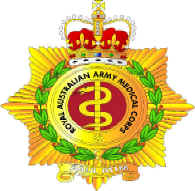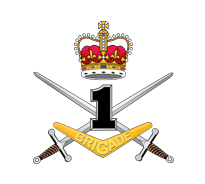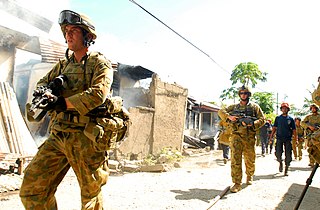Related Research Articles

Wagga Wagga is a major regional city in the Riverina region of New South Wales, Australia. Straddling the Murrumbidgee River, with an urban population of more than 56,000 as of June 2018, Wagga Wagga is the state's largest inland city, and is an important agricultural, military, and transport hub of Australia. The ninth largest inland city in Australia, Wagga Wagga is located midway between the two largest cities in Australia—Sydney and Melbourne—and is the major regional centre for the Riverina and South West Slopes regions.

Between February 1942 and November 1943, during the Pacific War of World War II, the Australian mainland, domestic airspace, offshore islands, and coastal shipping were attacked at least 111 times by aircraft from the Imperial Japanese Navy Air Force and Imperial Japanese Army Air Force. These attacks came in various forms; from large-scale raids by medium bombers, to torpedo attacks on ships, and to strafing runs by fighters.

The Royal Australian Army Medical Corps (RAAMC) is the branch of the Australian Army responsible for providing medical care to Army personnel. The AAMC was formed in 1902 through the amalgamation of medical units of the various Australian colonies and was first deployed to South Africa as a small detachment of personnel supporting the Australian Commonwealth Horse during the Second Boer War. The corps has participated in every Australian Army operation since then, including wars and peacekeeping operations. The "Royal" prefix was granted in 1948.
QantasLink is a regional brand of Australian airline Qantas and is an affiliate member of the Oneworld airline alliance. It is a major competitor to Regional Express Airlines and Virgin Australia Regional Airlines. As of September 2010 QantasLink provides 1,900 flights each week to 54 domestic locations.

1st Brigade is a combined arms formation of the Australian Army. Formed in 1903 as a militia formation based in New South Wales, it was reconstituted as part of the Australian Imperial Force in 1914 for service during World War I, the brigade fought at Gallipoli and on the Western Front before being disbanded in mid-1919. In 1921, the 1st Brigade was re-raised as a unit of Australia's part-time military forces, based in New South Wales. During World War II the brigade undertook defensive duties before being disbanded. In 1948, it was re-raised as an integral part of the Australian Regular Army. Currently the brigade is based at Robertson Barracks in Darwin and at RAAF Base Edinburgh near Adelaide, South Australia. It is the first of the Australian Army brigades to be re-organised as a combat brigade under Plan Beersheba.

The Canberra class is a ship class of two landing helicopter dock (LHD) ships built for the Royal Australian Navy (RAN). Planning to upgrade the navy's amphibious fleet began in 2000, based on Australian experiences leading the International Force for East Timor peacekeeping operation. With a new climate for growing Australian Navy spending, a desire existed for forward defence capability for landing and supporting troops on Asian territory, that had never existed in Australian history, even with the old Majestic-class light fleet carriers, HMAS Melbourne and HMAS Sydney in the 1970s. In 2004, French company Direction des Constructions Navales (DCN) and Spanish company Navantia were invited to tender proposals, with DCN offering the Mistral-class amphibious assault ship and Navantia proposing the "Buque de Proyección Estratégica" design. The Spanish design was selected in 2007, with Navantia responsible for construction of the ships from the keel to the flight deck, and BAE Systems Australia handling the fabrication of the combat and communications systems. Finally, Siemens (Germany) supplied and fitted the azimuth thrusters.
Air traffic control in Australia is provided by two independent organisations, one civilian and one military. The civilian provider is Airservices Australia, which controls civilian airfields and airspace. The military provider is the Royal Australian Air Force (RAAF), which controls military airfields and adjoining airspace. This includes Australian Army and Royal Australian Navy aviation bases. Some airfields in Australia are categorised as Joint User airfields, where there are both civilian and military operations based at the airfield. Normally, Joint User airfields have air traffic control provided by the RAAF.

Australia was a member of the international coalition which contributed military forces to the 1991 Gulf War, also known as Operation Desert Storm. More than 1,800 Australian Defence Force (ADF) personnel were deployed to the Persian Gulf from August 1990 to September 1991, while contingents from the Royal Australian Navy circulated through the region in support of the sanctions against Iraq until November 2001. In August 1990, two frigates HMAS Adelaide and HMAS Darwin and the replenishment ship HMAS Success left for the Persian Gulf. HMAS Success had no air defences, so the Army 16th Air Defence Regiment was embarked. On 3 December 1990, HMAS Brisbane and HMAS Sydney (IV) relieved HMAS Adelaide and HMAS Darwin. On 26 January 1991, HMAS Westralia replaced HMAS Success. A Navy clearance diving team was also deployed for explosive ordnance disposal and demolition tasks. Australian ships were in danger of sea mines and possible air attacks. In a number of recorded incidents, HMAS Brisbane encountered free floating mines, on one occasion narrowly avoiding a collision. Both HMA Ships Brisbane and Sydney encountered significant air threat warnings from Iran and Iraq throughout the initial period of the commencement of the Desert Storm Campaign. The detection of land based Silkworm anti-ship missiles from Iran throughout the campaign also added to the challenges for both crews as well as the multi-national Naval Forces.

Operation Astute was an Australian-led military deployment to East Timor to quell unrest and return stability in the 2006 East Timor crisis. It was headed by Brigadier Bill Sowry, and commenced on 25 May 2006 under the command of Brigadier Michael Slater. The operation was established at the request of East Timor's government, and continued under an understanding reached between Australia, East Timor, and the United Nations, with the United Nations Integrated Mission in East Timor supporting and helping to develop East Timor's police force. Other countries deploying soldiers to East Timor include Malaysia, New Zealand and East Timor's former colonial power Portugal, operating under independent command.

Albury railway station is a heritage-listed railway station at Railway Place, Albury, New South Wales, Australia, adjacent to the border with Victoria, in Australia. It was designed under the direction of John Whitton and built from 1880 to 1881. It was added to the New South Wales State Heritage Register in 1999.

The Australian Army Band Corps (AABC) is the Australian Army's musical branch. It is roughly the equivalent of the Music Branch and the Royal Corps of Army Music of the British Army. The Corps was formed on 2 August 1968 and provides the Army with musical support and seeks to improve the Army's public image. It consists of 11 individual bands; five full-time and six part-time which are located in the capital city of each state as well as the regional cities of Wagga Wagga, Townsville, and Newcastle.
Tenix Defence was Australia's largest defence contractor with core capabilities in Aerospace, Land, Marine and Electronic Systems applications. BAE Systems announced its intention to acquire the company from Tenix in January 2008 and the acquisition was completed in June 2008 for A$775 million. BAE Systems Australia thus became Australia's largest defence contractor.
The 16th Aviation Brigade commands all the Australian Army aviation units and has technical control of the Army Aviation Training Centre reporting to Army Aviation Command. The Brigade was formed on 2 April 2002 by combining Headquarters Divisional Aviation and Headquarters Aviation Support Group and is headquartered in Enoggera Barracks, Queensland. It was originally named Headquarters 16th Brigade (Aviation) and was renamed to the 16th Aviation Brigade.
Gaza Ridge Barracks is an Australian Army base in the suburb of Bandiana, located about 5 kilometres (3.1 mi) to the east of Wodonga, Victoria. Part of the Army Logistic Training Centre is based there. It is also home to the Army Museum Bandiana, a large and diversified military museum that hosts a number of collections focussing on the history of the Army's logistic corps. Gaza Ridge Barracks is also the home to the 37th Australian Army Cadet Unit.
The Army Logistic Training Centre (ALTC) is an Australian Army training establishment that is part of Forces Command. Established on 1 December 1995, through the amalgamation of nine separate logistic, health and personnel services schools and the Army College of TAFE, ALTC is headquartered at Bandiana, Victoria, and was established in response to the need to provide more effective logistic training, which had been identified as a problem as early as 1981. ALTC's motto is "Excel with Honour".
The Joint Health Command (JHC) is responsible for the delivery of military medicine and joint healthcare services to Australian Defence Force (ADF) personnel, including military psychiatry and rehabilitation services. The JHC is also responsible for providing strategic health policy, the development of the health preparedness of ADF personnel for operations, and the coordination of health units for deployment in support of operations. JHC is led by the dual-hatted Commander Joint Health and Surgeon General of the ADF.

The Australian Army Band Kapooka (AAB-K) is a full time military band in the Australian Army. Being a band, it is a sub-unit of the Australian Army Band, the army's official music branch. It is one of eleven military bands of the army and as the official band of the 1st Recruit Training battalion (1RTB). It performs regularly in its area of operations that includes Kapooka, Riverina, and Wagga Wagga. The current director of music is Major Michael De Jonge.
References
- ↑ "Everymans". Australian Defence Force . Retrieved 25 September 2013.
- ↑ "Parramatta City council". www.parracity.nsw.gov.au. Archived from the original on 29 August 2007. Retrieved 12 January 2022.
- ↑ "Archived copy" (PDF). www.parracity.nsw.gov.au. Archived from the original (PDF) on 30 August 2007. Retrieved 12 January 2022.
{{cite web}}: CS1 maint: archived copy as title (link)